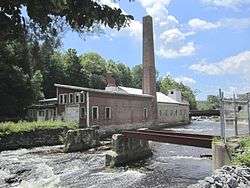George West

George West (February 17, 1823 – September 20, 1901) was an industrialist and a U.S. Representative from New York.
Life
Born in Bradninch, England, West attended the common schools. West emigrated to the United States in February 1849 and settled at Ballston Spa, New York in 1860.
Business career

In Ballston Spa West gradually acquired nine water-powered mills on Kayaderosseras Creek by 1879 manufacturing cotton, paper, and paper bags.
West was called "The Paper Bag King" because he was one of the first men in the country to manufacture paper bags at a time when most bags were made from cotton.[1] In 1869, he and the few other bag manufacturers in the country joined with Francis Wolle, inventor of the first paper bag machine, to form the Union Paper Bag Machine Company. Its only purpose was to "buy and fight patents."[2] This early trust was highly successful, as each member had access to all of the earliest paper bag patents and agreed not to compete with each other.[2]
West manufactured bags from manila paper made of inexpensive jute butts from India. Thus, he was able to sell them at a much lower cost than cotton sacks. They became extremely popular, and he sold millions per week. His paper bag factory in Rock City Falls was one of the first in the country to manufacture bags with machinery.
The success of his bags compelled West to purchase or build additional paper mills. By 1880 his mills consisted of the Union, Union Bag, Island, Eagle, Pioneer, Glen (pulp), Empire, Excelsior, and Middle Grove Upper and Lower mills, all situated on the Kayaderosseras Creek in Milton. He purchased his largest mill in the town of Hadley, New York on the Hudson River. West sold his paper mill empire to the Union Bag & Paper Company in 1899 for $1.5 million.[3]
He also served as President of the First National Bank of Ballston Spa from 1879 until his death.
Political career
West served as member of the New York State Assembly (Saratoga Co., 1st Assembly District) in 1872, 1873, 1874, 1875 and 1876 and was a delegate to the 1880 Republican National Convention.
He was elected as a Republican to the Forty-seventh Congress, holding office from March 4, 1881, to March 3, 1883. He was defeated by Edward Wemple in 1882, but returned to the 49th and 50th United States Congresses, holding office from March 4, 1885, to March 3, 1889. Afterwards he resumed his former business activities.
Personal
West married Louisa Rose (1822-1901) in England. The couple had six children, three of whom lived to adulthood. George (b.1845, Devonshire, England, d.1906, Ballston Spa, New York), Walter S. (1854-1875), and Florence L. (b.1856, Russell, Massachusetts, d.1934, Saratoga Springs, New York), who married D. W. Mabee.[4]
He was known as a philanthropist, donating funds to build a museum in Round Lake, New York, a Methodist church in Ballston Spa, and making liberal contributions towards the two soldiers' monuments in Saratoga County, in Ballston Spa and Schuylerville.
In 1901 West died at his mansion in Ballston Spa with a fortune that would today be worth $75 million.[2] His wife predeceased him by seven months. They are buried in the Ballston Spa Village Cemetery.
His original residence in Rock City Falls still stands on Route 29 as The Mansion Inn, now listed on the National Register of Historic Places.
See also
References
Sources
- United States Congress. "George West (id: W000302)". Biographical Directory of the United States Congress.
- Lost Industries of the Kaydeross Valley: A History of Manufacturing in Ballston Spa, New York; Timothy Starr, 2007
External links
| New York Assembly | ||
|---|---|---|
| Preceded by Isaiah Fuller |
New York State Assembly Saratoga County, 1st District 1872–1876 |
Succeeded by George W. Neilson |
| United States House of Representatives | ||
| Preceded by John H. Starin |
Member of the U.S. House of Representatives from New York's 20th congressional district 1881–1883 |
Succeeded by Edward Wemple |
| Preceded by Edward Wemple |
Member of the U.S. House of Representatives from New York's 20th congressional district 1885–1889 |
Succeeded by John Sanford |